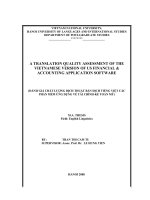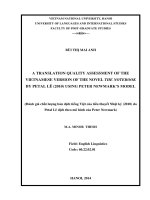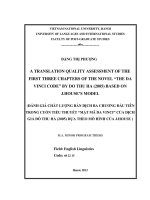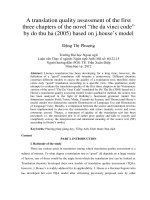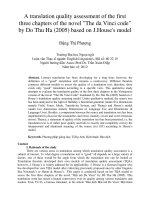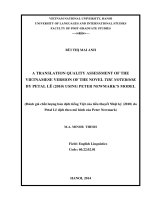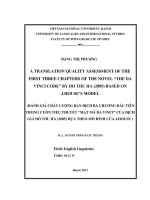A TRANSLATION QUALITY ASSESSMENT OF THE VIETNAMESE VERSION OF US FINANCIAL & ACCOUNTING APPLICATION SOFTWARE
Bạn đang xem bản rút gọn của tài liệu. Xem và tải ngay bản đầy đủ của tài liệu tại đây (676.31 KB, 72 trang )
VIETNAM NATIONAL UNIVERSITY,
HANOI UNIVERSITY OF LANGUAGES AND INTERNATIONAL STUDIES
DEPARTMENT OF POST-GRADUATE STUDIES
_______________********_______________
A TRANSLATION QUALITY ASSESSMENT OF THE
VIETNAMESE VERSION OF US FINANCIAL &
ACCOUNTING APPLICATION SOFTWARE
(ĐÁNH GIÁ CHẤT LƯỢNG DỊCH THUẬT BẢN DỊCH TIẾNG VIỆT CÁC
PHẦN MỀM ỨNG DỤNG VỀ TÀI CHÍNH-KẾ TOÁN MỸ)
M.A. THESIS
Field: English Linguistics
BY:
TRAN THI CAM TU
SUPERVISOR: Assoc. Prof. Dr. LE HUNG TIEN
HANOI 2008
TABLE OF CONTENT
DECLARATION
ABSTRACT
ACKNOWLEDGEMENTS
ABBREVIATIONS
Part A: INTRODUCTION
1. Reasons for Choosing The Topic
2. Aims of Study
3. Scope of Study
4. Research Method and Data
Part B: DEVELOPMENT
Chapter I: THEORETICAL BACKGROUND
I.1. Translation
I.1.1. Definition of Translation
I.1.2. Types of Translation
a. Technical Translation
b. Form-based and Meaning-based translation
I.2. Translation Equivalence
I.3. Translation Quality Assessment
I.3.1. Definition of Translation Quality Assessment
I.3.2. Aspects of Translation Quality Assessment
I.3.3. Steps in Translation Quality Assessment
I.4. Technical Language
I.4.1. Terminology
I.4.2. Information Technology Terms
a. Single terms
b. Compound terms
1
2
3
3
4
5
5
5
5
6
6
7
8
11
11
12
12
13
14
15
15
16
I.4.3. Application Software Terms
I.4.4. Financial and Accounting terms
I.5. Summary of Chapter's Findings
Chapter II: SOURCE -TEXT ANALYSIS
II.1. The author's Purpose
II.2. Characteristic of the Readership
II.3. The Topic
II.4. Language Qualities of Source Text
II.4.1. Features of SL Terms
a. Sub-technical terms
b. Highly technical terms
Single terms
Single terms as nouns, verbs and past participles
16
17
17
18
18
18
19
19
20
21
22
23
23
Single terms as acronyms
Compound terms
Compound terms as noun phrases
Compound terms as verb phrases
II.4.2. Application Messeges
II.5. Summary of Chapter's Findings
Chapter III: COMPARISON OF THE TRANSLATION WITH
THE ORIGINAL
III.1. The Translation of The Topic
III.2. The Translation of Terms
III.2.1. Sub-technical Terms
III.2.2. Highly Technical Terms
Single terms
Single terms as nouns, verbs and past participles
Single terms as acronyms
Compound terms
The translation of Noun phrases
The translation of Verb phrases
III.2.3. The Translation of Application Messeges
III.3. The Evaluation of the Translation
III.4. Sumary of Chapter's Findings
Part C: CONCLUSION
1. Issues addressed in the study
2. Suggestions for further study
REFERENCES
APPENDIX
1. Screenshot of Enterprise Complete Business Application Suite
2. Screenshot of example form of US F&A Application Software
3. Term Type Classification
25
25
26
28
29
29
32
33
34
34
35
35
36
38
38
39
40
41
42
44
45
45
46
DECLARATION
I declare that this MA Thesis, entitled A Translation Quality Assessment of The
Vietnamese Version of US Financial & Accounting Application, is entirely the result of
my own work. The thesis contains no material which has been accepted for the award of
any other degree or diploma in any university or tertiary institution, and to the best of
my knowledge, neither does it contain material previously published or written by
another person, except where due acknowledgement is made in the text.
Signature
Tran Thi Cam Tu
DEABSTRACT
This study investigates translation quality assessment of the Vietnamese version of US
Financial and Accounting application software translated by the pool of 20 translators
coming from VNLocalize, a big localization company in Vietnam with its head office in
Hanoi.
The introduction gives a rationale for the study and sets up aims, scope and methods of
the study.
Chapter I present the study’s theoretical background. It introduces the issues relevant to
the study including translation, translation equivalence, translation quality assessment,
technical language and terminology.
Chapter II analyzes the source language text with focus on the pragmatic accuracy, or in
other word the accuracy of meaning in context, of the US F& A application software.
The emphasis of the analysis will be on terminology meaning accuracy. Part of the
analysis will also deal with form of the SL text. The main group of terms will be divided
according to their meaning and the sub group of terms will be divided according to their
form.
Chapter III compares the original text with the translation and explores how the
translation has solved issues in the original text based on mostly the meaning and partly
the form aspects of the original text and then evaluation of the translation will be stated.
The conclusion summarizes the issues addressed in the study and gives suggestions for
further study.
ACKNOWLEGEMENTS
On the completion of this thesis, I would like to express my deepest gratitude to my
supervisor, Assoc. Prof. Dr. Le Hung Tien for transferring me his specialized knowledge
in translation, his inspiring me the love in translation studies as well as his valuable
suggestions, advice and correction during my writing up the thesis.
I also wish to express my sincere thanks to my friend, Van Thi Thanh Binh M.A. and
Nguyen Thi Thu Trang, post-graduate student for their insightful comments and
suggestions.
I also take this opportunity to thank all my lecturers in the Post Graduate Department at
College of Foreign Language, Vietnam National University, Hanoi for many of their
interesting lectures, which have surely contributed to the foundation of my thesis.
I owe my debt of gratitude to my big managers Bettina Richard and Jeewon Kim from
Oracle Worldwide Product Translation Group (WPTG) who encouraged me to continue
my MA study after my accident by giving me favorable working condition.
Finally, I would like to show my deep gratitude to my parents, my son and my sister for
their support, encouragement and understanding and even my father's pushing, without
which my thesis would not have been accomplished.
Hanoi, March, 2008
Tran Thi Cam Tu
ABBREVIATIONS
SL: Source Language
TL: Target Language
F& A: Finance and Accounting
UI: User Interface
IT: Information Technology
N: Noun
GL: General Ledger
PART A: INTRODUCTION
Translating US F&A terms in application software into Vietnamese is in big need at the
moment as there are numerous IT companies who are implementing the localization of
US F&A software for both public sector like the Ministry of Finance and private one
covering many enterprises. FPT, for example, a famous IT company with thousands of
employees can only take responsibility for a small portion of the translation. In addition,
many of the terms here are used in the F&A world which is a very hot industry in
Vietnam at the moment, with the mushrooming participation of many foreign and
domestic banks, financial organizations etc. However, it is quite a challenging task as
the size of the translation is very big and the big volume of terminologies both in
information technology and in finance and accounting also causes a lot of difficulties.
Another reason is that localization, which means the translation of software products, is
quite a new industry in Vietnam with very few translation companies operating in the
field. This new industry also implies another difficulty for the translators, which is the
fact that many terms are new to the target language. In such cases, we need to invent
terminology in the translation for complex business flows that are mostly a new concept.
To verify the huge scope and complexity of the translation project, I would like to have a
brief introduction about what US financial and accounting software is. Looking at the
graph in Appendix 1, we can see financial and accounting software is one software
among many other software that enterprises use such as Human Resource, Resource
Planning, Purchasing etc to boost the process of their business activities by replacing the
previous manual process with modern IT process now. The form (screen) in Appendix 2
will describe part of the automatic payment process we can use with the financial and
accounting application software.
Before now, there have been researches about Translation Quality Assessment like the
study by Julian House, Amos, Postgate, Newmark. However, no researches about
Translation Quality Assessment for Software Translation have been done, according to
the researcher’s best knowledge from the finding in different sources like professional
translation web sites like translationjournal.com or other local sources. Even, it is very
difficult to find document about language quality of software language, which is a very
challenging domain covering a huge number of terminologies in different industries like
IT, finance and accounting.
The general approach of the study is to research translation quality assessment for US
F&A accounting application software, finding out what are the language qualities of the
source text with specialization in computing and F&A terminology, comparing the
translation with the source text to decide how the translation have solved issues in the
source text and an evaluation of the translation will be made.
1. REASONS FOR CHOOSING THE TOPIC
The first reason that makes me to propose for the research is that few researchers have
done about translation quality assessment. In addition, as mentioned in the introduction,
no researches about Translation Quality Assessment for Software Translation has been
done, according to the researcher’s knowledge from the finding in different sources like
professional translation web sites like translationjournal.com or other local sources.
With investigation on qualities employed in the source text of US F&A application, the
researcher hopes to bring about clearer view on the nature of a technical text, which will
result in better translation.
Secondly, the researcher hopes that this study will be of some help to language
reviewers, especially the reviewers for application software translation, which is very
challenging task because application software is a new industry in Vietnam and the
application software translation is even a newer industry with a huge bulk of
terminologies of different specialized fields.
Finally, I choose to write about Translation Criticism because I am now working as a
language specialist for a global software translation organization with the main
responsibility to do translation review and give feedback to the translators about the
errors they encounter. Therefore, I especially enjoy the topic.
2. AIMS OF STUDY
The study covers the following aims:
a. To discover what language qualities the SL text of US F&A application software has
based on the language qualities of a technical language text
b. To assess the translation quality of the translated version of US F&A application
software, in terms of the aspects discovered from theories raised by different scholars
including Julian House; Peter Newmark; Baker, M., yet he translation quality
assessment will be mainly based on the theory of Newmark in A Textbook of
Translation (1988).
c. To provide a translation quality assessment tool, especially in technical translation, for
translation teachers and students, technical translation editors/reviewers in general and
software translation editors/reviewers in particular.
3. SCOPE OF STUDY
The object of the study is Translation Quality Assessment of the US F&A application
software conducted mainly based on the approach proposed by Newmark in A Textbook
of Translation (1988). Yet, due to the limited time and length of the thesis, the
researcher only focuses on three steps: (1) the source text analysis, emphasizing on its
language quality, which has the characteristic of technical language; (2) comparing the
translation with the original based on the qualities found in step (1); and (3) the
evaluation of the translation. Therefore, this should be treated as a pilot research project.
If time and the scope allow, a longer and more detailed research would be conducted,
viewing the SL text and the translation comparison from more different language
peculiars.
Other focus of the study is technical language, software language and terminology
covering finance, accounting and IT terms.
Research questions:
a. What are the qualities of SL text in US F&A application software?
b. What are the main problems in translation and how have the translators dealt with
them?
c. What should be included in the evaluation of the translation?
4. RESEARCH METHOD AND DATA
A combination of qualitative and quantitative research methods is used in this study. The
qualitative research is used to analyze the characteristics of the source text and how the
translation has solved the issues in SL text. The analysis of the source text will be based
on the theoretical backgrounds on translation concepts, translation equivalence, technical
language, terminology and most important of all is translation quality assessment
following Newmark's approach (1988) on Translation Criticism in A Textbook of
Translation. Quantitative method is used to count percentage of appearance of each
group of terminology, percentage of translation errors compared to the correct
translation.
The data for the study will be taken from 15 forms (screens) of the F& A application
software and their corresponding forms in the translation.
PART B: DEVELOPMENT
CHAPTER I: THEORETICAL BACKGROUND
I.1. Translation
How do we know when a translation is good? This simple question lies at the heart of all
concerns with translation criticism. But not only that, in trying to assess the quality of a
translation, one also addresses the heart of any theory of translation, i.e., the crucial
question of the nature of translation or, more specifically, the nature of the relationship
between a source text and its translation text.
From this viewpoint, we can see that translation quality assessment touches a lot of
areas, the nature of a good translation, the nature of relationship between a source text
and the translation text, which in other words can be called translation equivalence and
of cause the central issue would be translation quality assessment.
To understand the theoretical background for these issues in translation quality
assessment, the researcher would introduce literature review of translation, translation
equivalence, and translation quality assessment, and technical language. Especially, due
to the fact that there is a huge volume of terms in the SL text, then a part of theoretical
background is to deal with terminology.
I.1.1 Definition of translation
In Stolze's view, a 'good' translation can only come about when the translator identifies
him/herself fully with the text to be translated.
In Approaches to Translation, Newmark (1982, p7) states "Translation is a craft
consisting in the attempt to replace a written message and/or statement in one language
by the same message and/or statement in another language".
Followings are the definitions presented in What is translation and how does it work?
retrieved from />According to Bell, R.T (1991, p5), "Translation is the expression in another language (or
TL) of what has been expressed in another, SL, preserving semantic and stylistic
equivalence'.
Translation is the procedure which leads from a written SL text to an optimally
equivalent TL text, and which requires the syntactic, semantic, stylistic and text
pragmatic
comprehension
by
the
translator
of
the
original
text.
(Wilss, 1982)
Translation is the replacement of a representation of a text in one language by a
representation
of
another
equivalent
in
a
second
language.
(Hartman & Stock, 1972)
Translation consists in reproducing in the receptor language the closest natural
equivalent of the source language message, first in terms of meaning and secondly in
terms of style.
(Nida & Taber, 1974)
It is observed that the above definitions by different scholars in different times include
the two significant factors: the qualities of the original text covering meaning, style,
syntactic and pragmatic issues and the equivalence in the translation.
I.1.2. Types of Translation
This part will introduce three types of translation; namely technical translation,
meaning-based and form-based translation; which are closely related to the translation of
SL text presented in this thesis.
a. Technical translation
Newmark (1991, p151) as cited in Yen, V. T. T. (2007), in an attempt to distinguish
technical translation from institutional translation, claims that technical translation is
one part of specialized translation, potentially non-cultural, therefore, universal.
According to Sofer (1991, cited in Thuy, V.T.T. 2003), the translation of a text may be
called technical when it requires specialized terms in a particular field.
Newmark (1995, p152) suggests that there are three varieties or levels of technical
language: (a) academic style associated with academic papers, (2) professional style
which refers to formal terms used by experts and (3) the popular one including familiar
alternative terms.
According to Thuy, V. T. T. (2005), a significant problem in technical translation is the
distinction between technical and descriptive terms. The original SL writer may use a
descriptive term for a technical object for three reasons (1) the object is new and has not
got a name; (2) the descriptive term is being used as a familiar alternative, to avoid
repetition; (3) the descriptive term is being used to make a contrast with another one.
According to Newmark, where a SL technical term has no known TL equivalent, a
descriptive term should be used.
b. Form-based and Meaning-based translation
Treatments of the two text properties, form and meaning, is the main distinction between
the two main types of translations: the form-based and the meaning-based ones (Larson,
1984, cited by Binh, V.T.T.).
Form-based translations, known as literal translations, attempt to follow the form of the
source language text. Meaning-based translations, or idiomatic translations, make every
effort to communicate to text receivers the meaning of the source language text in the
natural forms of the target language (Larson, 1984).
In practice, translation is a mixture of a literal transfer of the grammatical units a long
with some idiomatic translation of the meaning of the text.
Larson gives more details of these two types of translation in the following part:
Translation is basically a change of form. When we speak the form of a language, we are
referring to the actual words, phrases, clauses, sentences or paragraphs, which are
spoken or written.
Translation consists of transferring the meaning of the source language into the receptor
language. This is done by going from the form of the first language to the form of a
second language by way of semantic structure. It is the meaning which is being
transferred and must be held constant, only the form changes. Translation, then, consists
of studying the lexicon, grammatical structure, communication situation and cultural
context of the source language text, analyzing it in order to determine its meaning, and
then reconstructing this same meaning using the lexicon and grammatical structure
which are appropriate in the receptor language and its cultural context.
With regard to meaning, Larson states that most words have more than one meaning.
There will be a primary meaning – the one which usually comes to mind when the word
is said in isolation and secondary meanings – the additional meanings which a word has
in context with other words.
I.2. Translation Equivalence
From the definitions of translations by different scholars, it is clear that equivalence is
the central issue in translation studies.
Andrew Chesterman, in "Readings in Translation Theories"(p100), describes that there
are "various categories of equivalence that have been proposed in the literature of
translation theory: content equivalence (often also: content invariance), stylistic
equivalence, formal equivalence, functional equivalence, textural equivalence,
communicative equivalence, pragmatic equivalence".
From the view point of Juliane House (1977, p25), meaning equivalence is the most
essential in translation: "The essence of translation lies in the preservation of 'meaning'
across two different languages".
"SL and TL texts or items are translation equivalents when they are interchangeable in a
given situation", (Catfort, 1965, p49)
Newmark (1995, p48) states that "The overriding purpose of any translation should be
to achieve 'equivalent effect', i.e. to produce the same effect (or one as close as possible)
on the readership of the translation as was obtained on the readership of the original". In
this statement, Newmark emphasizes the importance of functional equivalence as "the
overriding purpose of any translation".
Koller cited in Readings in Translation Theory (Chesterman, A., 1989) views
equivalence in term of the maintenance of the SL and TT quality. According to him
(1979), the equivalence requirement of a translation to its origin is as follows: " Quality
(qualities) X in the source language text must be preserved." The qualities can be
understood as the different characteristics the source text has, which must be preserved
in the translation text. These characteristics may include the style, meaning, readership
and purpose of the text.
According to Baker, equivalence at word level covers a number of factors relating
number, gender, and part of speech. She claims that different grammatical structures in
the SL and TL may cause remarkable changes in the way the information or message is
carried across (noun phrase in SL can be translated as verb phrase in TT).
In much more elaborate view point, Kade (1968) and other writers on lexical
equivalence, in particular the area of terminology, classify translation equivalence as
follows:
1. One-to-one: There is a single expression in the TL for a single expression in the SL.
2. One-to-many: There is more than one expression in the TL for a single SL one.
3. Many-to-one: There is more than one expression in the SL, but there is only a single
expression in the TL that is equivalent to them.
4. Whole-to-part/Part-to-whole: A TL expression is only equivalent to part of the
concept designated by a single expression in the SL, or the equivalent in the TL has a
broader meaning than the concept in the SL.
5. One-to-zero: There is no expression in the TL for a single expression in the SL.
Koller (1979) stated the following five types of equivalence referring to the lexical
meaning equivalence: (1) Denotative equivalence: the SL and TL words refer to the
same thing in the real world, (2) Connotative equivalence: this type of equivalence
provides additional values besides denotative value and is achieved by the translator's
choice of synonymous words or expressions, (3) Text-normative equivalence: the SL
and the TL words are used in the same or similar context in their respective languages,
(4) Pragmatic equivalence: With readership orientation, the SL and TL words have the
same effect on their respective readers, and (5) Formal equivalence: This aims to
produce an "analogy of form" in the translation by exploiting the formal possibilities of
the TL or even by creating new forms if necessary.
Baker, M. (1992) views the concept of equivalence differently by discussing the notion
of non-equivalence at word level and above word level, grammatical equivalence,
textual equivalence and pragmatic equivalence.
Non-equivalence at word level means that the target language has no direct
equivalent for a word which occurs in the source text. Common problems of nonequivalence then involve such cases as culture-specific concepts, the SL concept
is not lexicalized in the target language, the SL word is semantically complex,
the SL and TL make different distinctions in meaning, the TL lacks a superordinate, the TL lacks a specific term, differences in physical or interpersonal
perspective, differences in expressive meaning, difference in form, difference in
frequency and purpose of using specific forms, the use of loan words in the
source text.
Non-equivalence above word level is closely related to the differences in the
collocational patterning of the SL and TL, which creates potential pitfalls and
can pose various problems in translation.
Grammatical equivalence is more concerned with the differences in the
grammatical structures of the SL and TL, which often result in some change in
the information content of the message during the process of translation. This
change may take the form of adding to the target text information which is not
expressed in the source text. This can happen when the TL has a grammatical
category which SL lacks. Likewise, the change in the information content of the
message may be in the form of omitting information specified in the source text.
If the TL lacks a grammatical category which exists in the SL, the information
expressed by that category may have to be ignored.
Textual equivalence is achieved through the realization of cohesion, or cohesive
devices such as reference, substitution, ellipsis, conjunction and lexical cohesion
from the source text into the target text.
Pragmatic equivalence is realized by means of studying and translating
coherence and implicature from the SL to the TL.
Larson, M.L (1984) points out "there will be concepts in the source text which are
known (shared) in the receptor language, but which will be translated by a non-literal
equivalent, second there will be concepts in the source language which are unknown in
the receptor language". In both cases, new terms must be invented for the translation.
